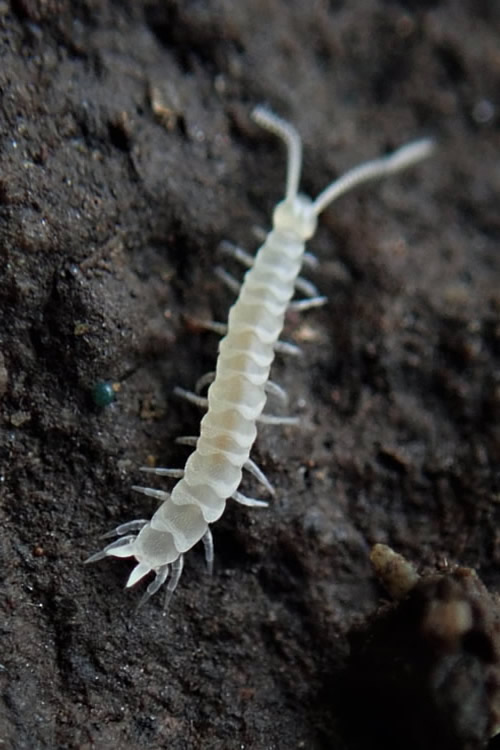Symphylans resemble miniature whitish centipedes with one pair of legs per body segment, but they have only 12 pairs of legs (the first pair may be much reduced and not easily visible in some species). They vary in size from 1.5 mm up to 8 mm in length. The head bears prominent, very flexible, antennae with between 5-60 segments and eyes are absent. The rear end bears a pair of prominent conical cerci bearing setae.
They can often be seen running rapidly over the soil surface when stones are turned over. They occur in all sorts of soils and can be present in large numbers (up to 80 million per acre in one estimate). They can sometimes become a serious greenhouse or outdoor pest attacking the roots of young plants.
The British and Irish checklist currently includes just 14 species (of which 2 only known from inside heated glasshouses). The group have not been well studied; primarily due to their small size they can be difficult to identify. There will undoubtedly be more species awaiting discovery, especially as some of the Scutigerella are thought to be cryptic species.
Identification guides to British & Irish species:
Andersson, G., Meidell, B.A., Scheller, U., Winqvist, J.-Å., Osterkamp Madsen, M., Djursvoll, P., Budd, G. & Gärdenfors, U. (2005). Nationalnyckeln till Sveriges flora och fauna. Mångfotingar. Myriapoda. (CF). Uppsala: ArtDatabanken, SLU. [text in Swedish]
Edwards, C.A. (1959). A revision of the British Symphyla. Proceedings of the Zoological Society of London, 132: 403-439.
Hopkin, S.P. & Roberts, A.W. (1988). Symphyla – the least studied of the most interesting soil animals. Bulletin of the British Myriapod Group 5: 28-34.
Systematic Check List
Based on Edwards (1959) & Hopkin & Roberts (1988). Nomeclature updated to follow MilliBase (2017) ~ https://millibase.org
Class SYMPHYLA
Order CEPHALOSTIGMATA
Family Scutigerellidae
Scutigerella linsleyi Michelbacher, 1942 - common
Scutigerella palmonii Michelbacher, 1942 - common
Scutigerella immaculatus (Newport, 1845) - common [syn. S. immaculata]
Scutigerella lineatus Edwards, 1959 - rare
Scutigerella causeyae Michelbacher, 1942 - common
Hanseniella unguiculata (Hansen, 1903) - inside hothouses
Hanseniella caldaria (Hansen, 1903) - inside hothouses
Hanseniella hanseni (Bagnall, 1913) - rare [syn. Neoscutigerella hanseni (Bagnall, 1913); Scutigerella hanseni Bagnall, 1913]
Family Scolopendrellidae
Scolopendrellopsis subnuda (Hansen, 1903) - quite common [syn. Symphyllelopsis subnuda (Hansen, 1903)]
Scolopendrellopsis arvernorum (Ribaut, 1931) - quite common [syn. Symphyllelopsis arvernorum Ribaut, 1931]
Scolopendrella notacantha Gervais, 1840 - rare
Symphylella isabellae (Grassi, 1886) - common
Symphylella elongata Scheller, 1952 - common [syn. Symphylella hintoni Edwards, 1959]
Symphylella vulgaris (Hansen, 1903) - common
Image by Christian Owen
